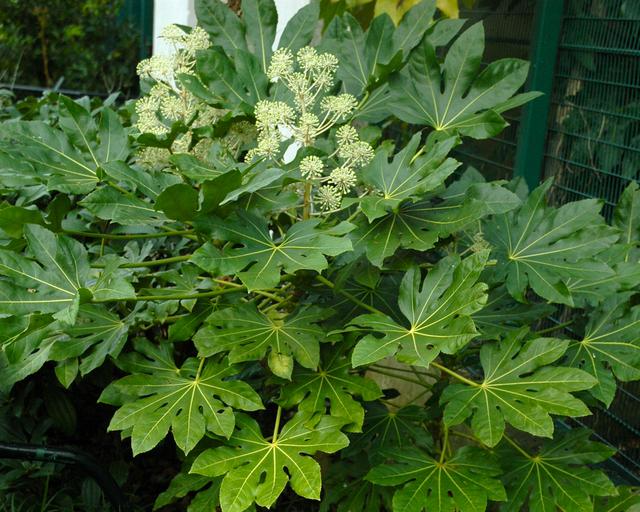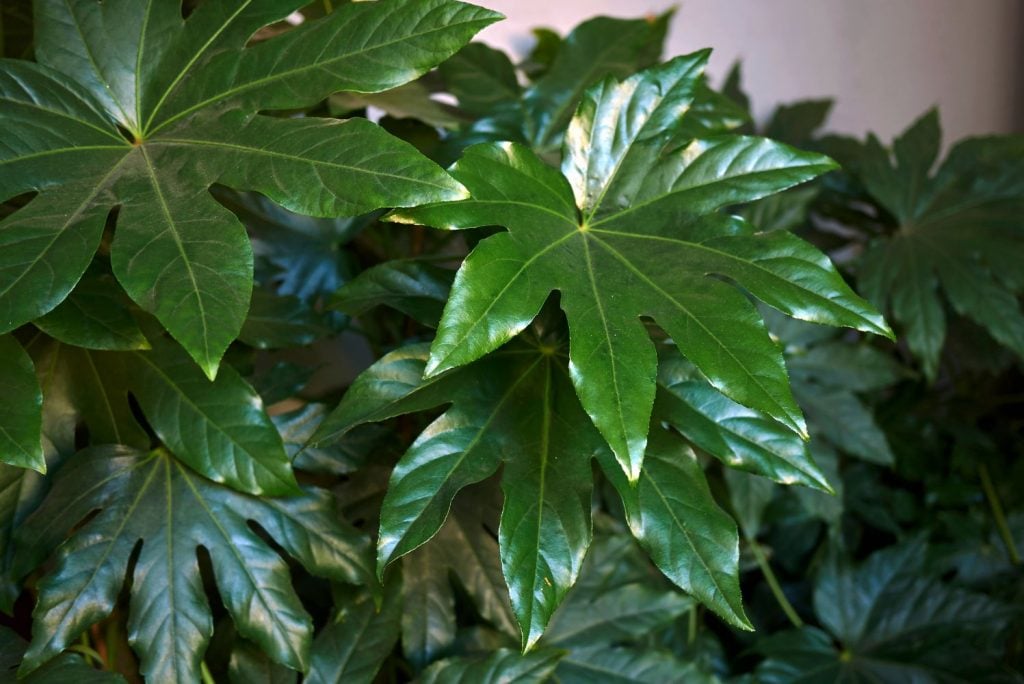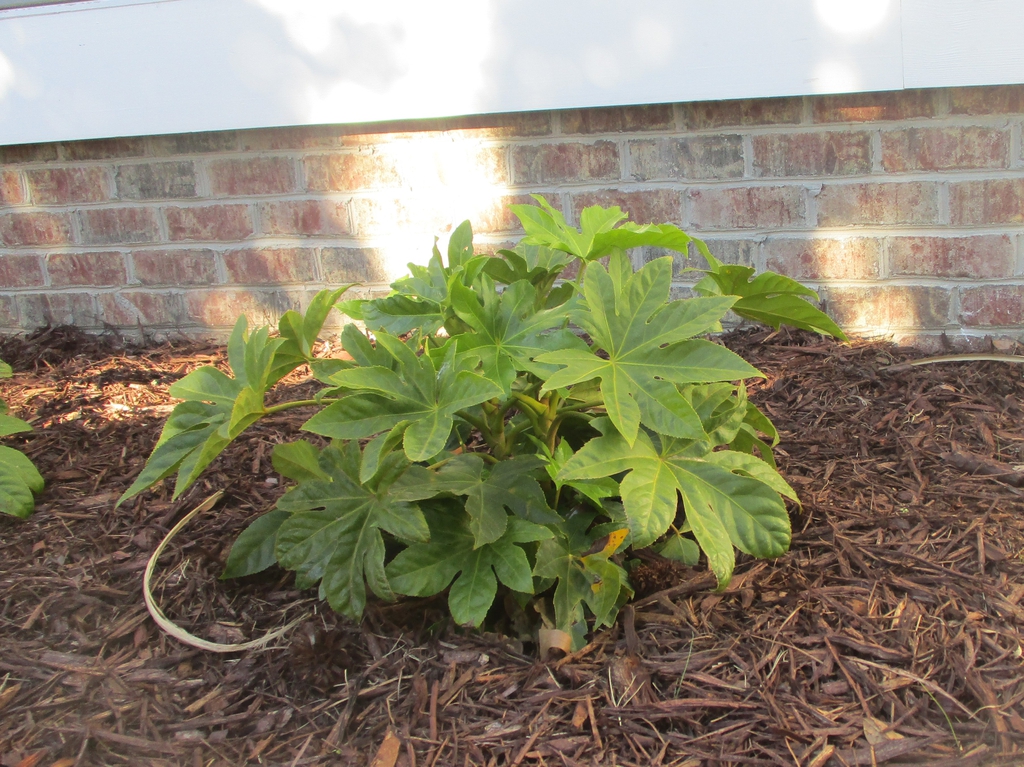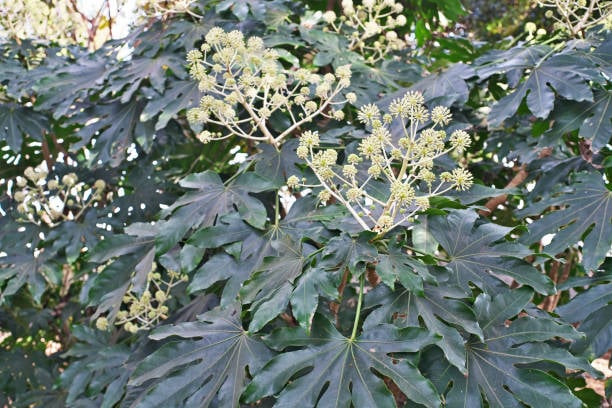Table of Contents
Fatsia Japonica, commonly called Japanese Aralia, is a common household ornamental shrub known for its broad leaves and roundish flowers. It can be grown in a garden or kept as a houseplant.
The broad and glossy evergreen leaves with white flowers and black berries sure add a touch of luscious beauty to your home. Fatsia Japonica grows to about 10 feet on maturation and often leans to one side due to the weight of the leaves. It creates quite a lush appearance owing to its palm-sized leaves and clustered look.
If you are looking to grow Fatsia Japonica in pots for your home or give your garden a little exotic touch with these plants, here’s a beginner’s guide to growing and caring for your Fatsia Japonica.
Choosing the Right Variety of Fatsia Japonica Shrub to Grow

Choosing the right variety to grow is as important as taking care of your plant. There are several varieties of Fatsia Japonica. You can choose which one you want to grow depending on your requirement. These varieties can be easily found online or in the nursery near your home.
1. Fatsia Japonica ‘Variegata’
If you are looking to grow Fatsia japonica in pots as an indoor plant, this is the best variety to choose from. Its features beautiful leaves with cream-coloured edges and goes on to grow roundish small cream flowers in clusters.
2. Fatsia Japonica’ Spider’s Web
This variety is suitable both for growing indoors as well as outdoors. Named after the web-like appearance of leaves, this variety produces large palmate leaves. Although a slow grower, this variety is widely used by people all around the world.
3. Fatsia X Fatshedera Lizei
It is an intergeneric cross of Fatsia Japonica and Hedera Helix (common Ivy), which carries the broad, glossy leaf and roundish flower quality of Fatsia and the Vine-like qualities of Ivy. It can be easily made to grow as a vine by providing support or can also be left to grow on the ground.
How to Grow Fatsia Japonica

Fatsia Japonica is a tropical plant that needs to be in full shade to thrive. It is important to understand the difference between full shade and full sun in order to be able to give your plant what it needs. A full-shade plant does not need direct sunlight; it needs to have reflected sunlight. Direct sunlight from the full sun can do more harm than benefit. So if you are growing Fatsia Japonica in pots, it is necessary to keep it in a place that does not attract too much direct sunlight.
Choose slightly acidic soil and good-quality compost for planting. Choose a medium to large-sized pot to plant it, as it will grow to have wide leaves, and the plant is almost 8-10 feet tall. Fatsia Japonica is quite flexible and can be grown in a variety of spots, be it a room, patio or garden.
An ideal place for growing the plant will be a shady and cool room, although it can also thrive well in sunny locations as long as the sunlight is not direct. Spring season is best for planting Fatsia Japonica so the plant can develop fully during the coming summer when there will be ample sunlight. It needs about 6 hours of indirect sunlight.
Follow These Simple Steps to Grow Fatsia Japonica
- Buy a good quality plant that has hardened off to be used on the grounds or at home in a pot.
- Plant it in a hole such that the width of the hole is twice that of the rootball. Also, make sure the depth of the hole remains the same as it was in the pot that it came in.
- Add good-quality compost or blood fish and bone fertiliser, replace the soil and tap it with your hands to make it firm.
- Water the soil such that the soil remains moist at all times. If you are growing Fatsia Japonica in pots or containers, keep an eye on it, as they tend to dry more quickly than those planted on the ground.
- Make sure to buy only healthy plants that are free from pests and diseases. It is a widely known fact that these plants do require a certain amount of attention, they can be a bit challenging to manage at times, but given the right amount of care, these plants bloom to give out healthy and beautiful flowers.
- The most important point to keep in mind while growing Fatsia Japonica in pots is that the pot you have chosen is at least 60 cm in width and height. Since the plant grows up to have larger leaves, it should be large enough to accommodate the stem and dense leaves. You will need to shift it into an even larger pot after 2-3 years and prune the plant to maintain it.
- If you want to go with a variety that grows slowly and reaches a smaller height than usual ones on maturity, you can choose to go with Fatsia japonica ‘Spider’s Web’. It is ideal for keeping as an indoor plant, being a low-maintenance option.
Caring for Your Fatsia Japonica Shrub

Fatsia Japonica is a high-maintenance plant that will need your attention to grow properly. However, here are a few things that you can do to keep your Japanese Aralia in great condition and put it in an uncomplicated spot requiring lesser care.
1. Watering Requirements
Fatsia Japonica requires a proper watering system during its initial period of growth. Make sure that the soil remains moist but does not get too soggy. Damp soil promotes proper root growth. Therefore, it is highly recommended to water it consistently after planting it. After the root system has been established, you can gradually reduce the watering, although make sure that the soil doesn’t get dry.
2. Sunlight Requirements
Fatsia Japonica despises direct sunlight; a cool shady place with indirect sunlight works best for it. If you are planting Fatsia Japonica in pots, you can plant it under other taller and bushier shrubs to make a shady place for this plant. Try to maintain a minimum of 6 hours of sunlight to let it grow to its actual length.
3. Soil Requirements
For potting Fatsia Japonica, the ideal kind of soil is nutrient-rich organic soil. The kind of soil which drains easily is the perfect choice for growing this plant. A notable thing here is to ensure that the soil does not retain water for a long time and flows freely, as too much water can make its roots rot.
4. Choosing the Right Fertiliser
The best time to add fertiliser is early summer or spring season. You can add slow-release fertiliser or compost during the early summer or spring and additionally use a half-diluted balanced fertiliser every two weeks.
5. Temperature and Moisture Requirements
The ideal temperature for Fatsia Japonica is 60-80℉. It thrives well in a warm tropical environment. During winters, the period of dormancy, its temperature requirement changes to 45-55℉.
This plant also requires high humidity; in the absence of a properly humid environment, its leaves begin to curl up and dry out. You can get a humidifier to maintain its moisture level. Especially in areas which often have low humidity, it is recommended to check with your gardener beforehand if these plants would be able to survive or not.
6. Pruning
In the absence of pruning, Fatsia may grow to take up a large space. It becomes difficult to manage, especially if you are growing your Fatsia Japonica in pots indoors. So, it is important to cut the overgrown stem of the plant to maintain a nice height and width.
7. Winter Protection
It is necessary to apply thick mulch to protect the plant during extreme cold. You can also cover the plant with a fleece blanket to keep them protected during harsh winter conditions.
8. Pest Control
Fatsia Japonica is quite prone to attack by mealy bugs. These cotton-like pests are often found attached to the inside of the fatsia leaves. They tend to take away the nutrition from the plant rendering them devoid of the requisite nutrients. To keep them away, wipe the broad leaves gently. You can also use rubbing alcohol to drive these pests away.
Conclusion
If you are looking to grow these beautiful ornamental plants featuring eight-lobed leaves and bushy white flowers, remember to choose the variety as per your requirement. Planting Fatsia Japonica in pots as an indoor plant is highly recommended due to its ability to remove formaldehyde from the air.
Grow it in acid-rich soil, with enough humidity and temperature and keep feeding the right fertiliser to keep the plant in good condition. Make sure the cultivars you have chosen are pest and disease free.
These are a few tips for growing and caring for your Fatsia Japonica plant; if you follow these steps properly, you can expect your Fatsia to grow green and luscious.
Frequently Asked Questions (FAQs)
Why Pruning Fatsia Japonica Is Necessary?
Fatsia Japonica tends to grow up to 3 ft. Its leaves are also quite big and take up a large space. Pruning ensures that they grow in the right direction and to an optimal height.
Is Fatsia Japonica Prone to Diseases?
Yes! Fatsia Japonica often finds itself trapped in a disease. The two most common diseases that occur in this plant are Etiolation and Octagonal disc leaf spot. Etiolation is a disease in which its leaves turn yellow-green due to a deficiency of iron or other minerals and nutrients. The octagonal disc leaf spot causes spots to appear on the leaves, which keeps on increasing and ultimately causes the leaves to wilt.





